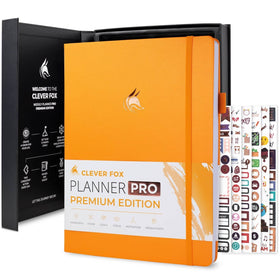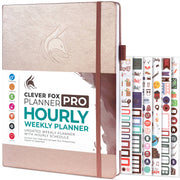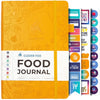8 Ways to Use Your Paper Planner Effectively

We all make goals, but studies have found that goals we write down are the ones we’re most likely to reach. That’s why a paper planner can be one of the best tools in your time management kit. It's also why organization experts recommend paper planners over digital planners every time.
The right paper planner can boost your productivity and help you reach your goals, but you have to know how to make the most of one. Here’s how to choose the right paper planner—and how to use it the right way.
Choose the Right Format
You’re looking at dozens of planners online or in a store, and you don’t even know where to start. How do you choose the one that will magically make you more organized and productive?
Well, no planner is magic, but the best way to start is by deciding whether you want a daily or weekly planner. There are advantages and disadvantages to both, and neither is objectively better. It depends entirely on what works for you.

|
Benefits of a Daily Format:
Downsides of a Daily Format:
|
Benefits of a Weekly Format:
Downsides of a Weekly Format:
|
As you can see, both formats have benefits, and either one will work for you. Start by picking a format you like, and look for a planner that comes with the extras you need like checklists, shopping lists, stickers, and other features that help you stay productive.
Make It a Habit
Most motivation experts tell you that the key to making big changes is developing small habits. How do you do that when it comes to planning? Instead of thinking, “I’m going to totally overhaul my life and get super-organized,” start small. Decide you’ll spend at least five minutes every morning looking at your planner.
Once you start doing this regularly, it will become a daily habit like making coffee or taking a shower. Over time, that little habit lays the foundation for a more organized and productive life.
Here are some tips to help you develop the planner habit:
- Leave your planner out in the open.
- Start by spending five minutes a day on your planner.
- Choose a planner that’s fun and easy to use.
- Use one planner for everything.
Write It Down
Your planner is more than a simple time scheduler. It’s the journal of your hopes and dreams. Use it to track the details of every day.
- Fill in your appointments.
- Write your shopping lists.
- Create reminders about bill payments.
- Include details like phone numbers and addresses, so you don’t have to keep looking them up.
- Jot down birthday and anniversary reminders.
- Write motivational notes to yourself.
If you want to achieve more, write it all down in your planner. Jot down your daily thoughts, signs of progress, and even little musings you think are unimportant. It all counts, and it all adds up. Use your planner to chart the story of your life
Spell Out Your Goals
When you first look at all those blank spaces, you may feel excited, but you may also feel overwhelmed. You have so many things to do, and you don’t think you have time to manage all of them.
The beauty of a planner is that it shows you, clearly and tangibly, that you really can get it all done, but you must start by writing in that planner. As we said at the start, writing your goals down is a powerful way to achieve them. Studies have found that people who write down their goals are 42% more likely to reach them. There are several reasons for this:
- Writing them down means you’ll be accountable to yourself.
- You may forget your priorities when you’re overwhelmed by trying to make it through a tough day. Seeing your goals written down will remind you of what you’re doing and what you want to accomplish.
- Writing down your goals also means writing down the steps you need to reach them, and it gives you a chance to see how much progress you’ve made.
Your planner will help you chart your path to victory, so use it daily.
Manage Time by Blocking It
If you’ve ever read anything about time management, you’ve probably heard about time blocking. What is it, and how can it work for you?
Time blocking means that instead of getting distracted trying to multitask or allowing yourself to be interrupted when you’re working on something, you block out specific times for specific tasks. For instance, instead of checking your email every time you hear that “ping,” you set aside a specific time during the day when you’ll spend 15 to 20 minutes reading and responding to emails.

Time blocking prevents procrastination and boosts your productivity. When you get good at it, you’ll be able to block out leisure time, mealtimes, and all your top-priority projects. Here’s an example of how you might block out a typical day at work:
- 8:30 to 9:00 am: Check emails.
- 9:00 am to 11:00 am: Work on a priority project.
- 11:00 am to 11:30: Check phone messages and make calls.
- 11:30 to 12:30: Eat lunch.
- 12:30 to 2:30: Work on key projects.
- 2:30 to 3:30: Weekly staff meeting.
- 3:30 to 4:30: Finish any work left from the previous day.
- 4:30 to 5:00: Submit any finished projects, and plan the next day.
This is a basic schedule, but you get the idea. Do your best to block out time for all your important projects, and try to avoid distractions.
The best part about a paper planner is that it makes time blocking easy. Write your projects in chunks of time each day, stick to your schedule, and watch your productivity soar.
Set Daily and Weekly Appointments with Yourself
When you’re filling out that planner, don’t forget to schedule daily, weekly or monthly appointments with yourself. It’s a great way to keep yourself accountable. This is an excellent way to track your progress, which is easy to do if you’ve written everything down in your planner. Ask yourself:
- Did you get everything on your list done?
- How did you feel when you crossed off that final item?
- What do you have planned for tomorrow?
- What does your upcoming week look like?
- How much closer are you to your goals?
- If you’ve had setbacks, how can you resolve them?
These weekly or daily appointments help you track your progress and keep you motivated.
Color Your Life—and Your Planner

Many of today’s planners come with color-coded stickers, reminder tags, and even built-in folders. Many people further personalize their planners by using colored pens, adding their own stickers, and including items they found throughout the day.
These make using your planner fun, but they also serve a serious purpose. Many people stop using their planners because they get bored with them. Using stickers will make planning more fun.
There are three types of stickers that come with most planners.
- Functional: These stickers alert you to specific tasks, to-do lists, and urgent deadlines.
- Sidebar: These run along the side of the planner, and they’re useful as places to jot reminders about upcoming events.
- Decorative: Decorative stickers add charm and beauty to your planner.
Many planners come with their own stickers, but you can buy custom stickers in every color, style and theme.
Make It Your Own
Some people get stressed out when they see rows of empty days in their planner, and other people freak out when they see a planner that’s packed with activities. Which one are you?
Everyone uses planners differently. Some people fill the pages with perfectly neat notes, and others fill them with scrawled reminders, exclamation points, circles, and more. Neither way is correct.
If your way of using your planner works for you, there’s no need to change it. If you’re getting everything on your checklist done, it doesn’t matter whether your planner is pristine or messy.
Plan Your Life
A paper planner can help you stay focused, become more productive, and hit all your goals. If you need help choosing the right one, check in with the experts at Clever Fox. We create beautiful, well-designed planners for every purpose and every work style. We can help you find the one that's a perfect fit for you.














